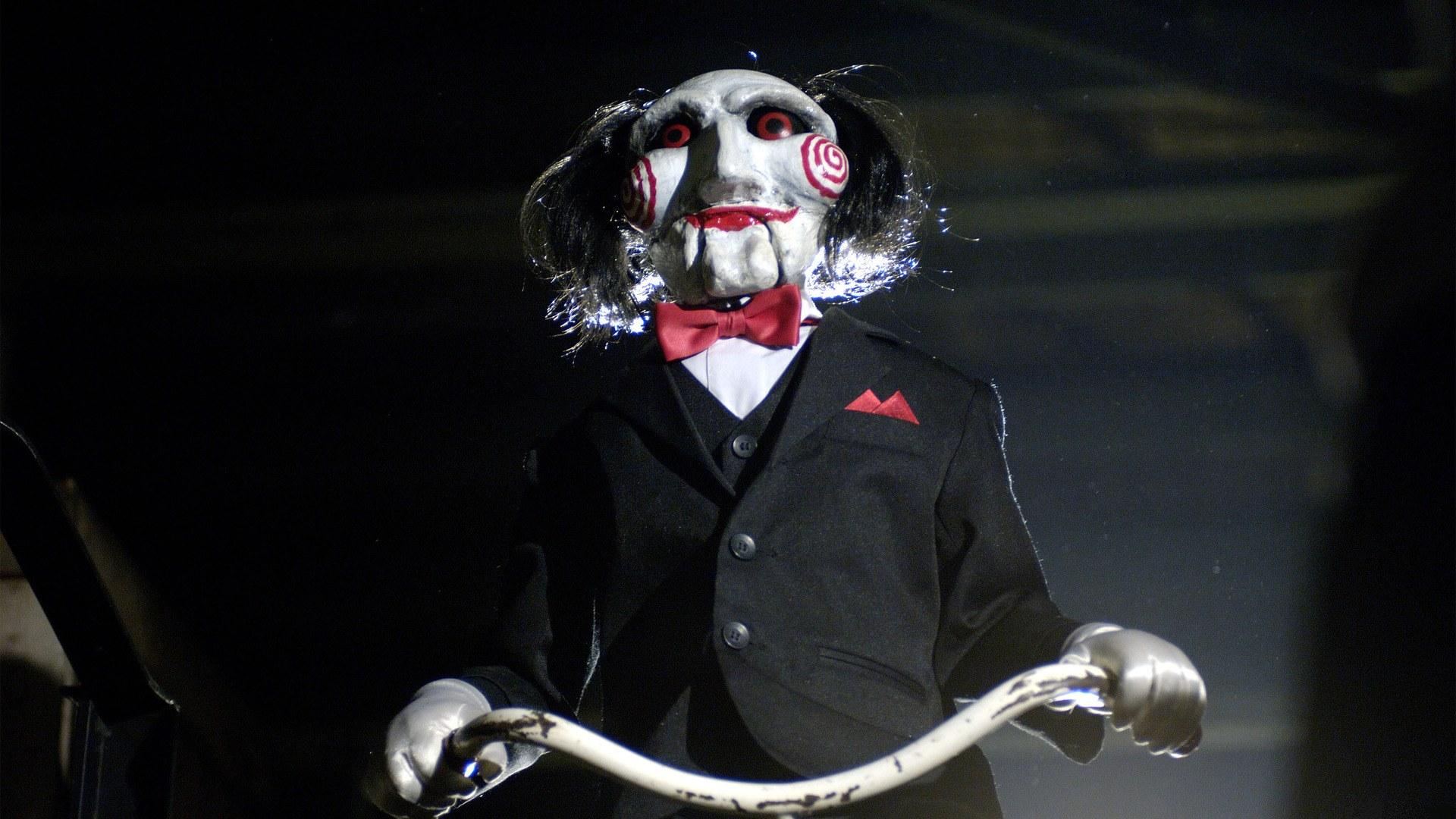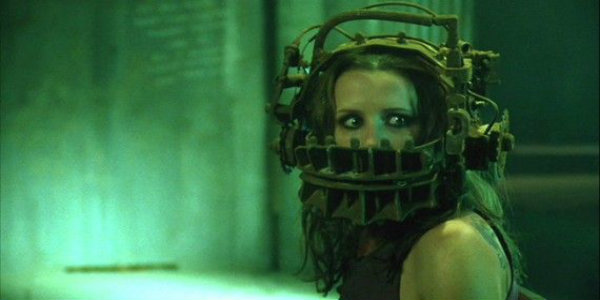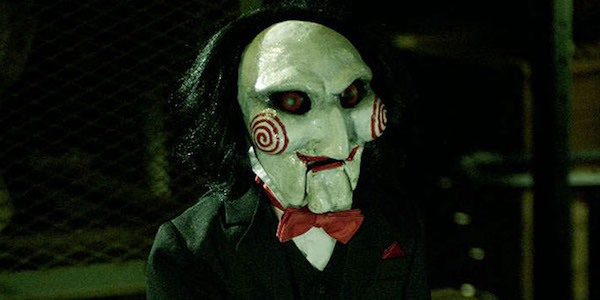The Dawning Of A New Age In Horror: SAW

Michael Pementel is a Columbia College Chicago graduate of the…
Our story begins with a man waking up in a bathtub. It’s pitch black as he climbs out in panic, stretching his arms out to find some form of support. He hears a voice across from him, and suddenly the lights turn on. The man finds himself in a decrepit bathroom, chained to the wall like the man across from him, and there is a dead body lying in the middle of the floor.
Thus begins the journey for one of horror’s greatest film franchises, Saw. Since its theatrical release in the States on October 29th 2004, the film and its franchise have garnered both a cult and mainstream following. For many horror fans, Saw was their Evil Dead, Nightmare on Elm St., or Friday the 13th – their first horror movie.
What drew fans into the film was the gore and torture, and the imaginative “games” the villain of Jigsaw would create. Saw is a film that started with the smallest idea, and while the rest of the movies would go on to reshape those original ideas with glitz and glam, the first film stands as a testament to brilliant filmmaking. By combining unique story ideas, jaw dropping violent visuals, and effective uses of a small budget, Saw would grow to become one of the most important horror films of our time.
Just Two People In a Bathroom
Saw is the child of James Wan (director), and Leigh Whannell (screenplay writer). The two friends shared a love for cinema, and wanted to write and fund their own movie. One of the original inspirations for Saw actually came from The Blair Witch Project; both Wan and Whannell saw that to make a horror film effective and scary, one didn’t necessarily need a ton of money. The two saved up enough to put together a short film version of the project, and eventually found the support of distribution through Lionsgate.
Given their drive to create a film, and with their mentality to make it affordable, they realized the best way to go about it was to make the film condensed. By primarily focusing the story on just two men in a room, it allowed them to save on their budget, while still getting the story across.

These budget restraints would also apply to the actual look of the picture. Wan originally wanted Saw to have a “Hitchc*ckian” style, but due to the lack of time they could afford in shooting, not every scene could be planned as ideally. However, this is what would allow for Saw’s rough and gritty camera work, helping to bring in an atmosphere of grime and dread to each scene.
This atmosphere is an immense part of Saw – but what makes the movie a work of nightmares isn’t its setting, but its story and ideas.
“I Want To Play a Game”
Adam (played by Whannell) and Dr. Gordon (played by Cary Elwes) find themselves chained to the walls of an old and rotted out bathroom. They eventually discover tape cassettes in their pockets, also noticing that the corpse in the middle of the room is holding a tape recorder. While Adam’s recording is vague in regards to what his purpose in the room is, Dr. Gordon’s tape reveals that in this “game”, he must kill Adam.
We as the audience, along with the two main characters, learn that they are trapped in one of the infamous games of the Jigsaw Killer (played by Tobin Bell). Jigsaw’s aim is typically to kidnap people who are unappreciative of their lives, and force them into a situation that has them face their wrongdoings, paying for their decisions.

While Saw primarily focuses on Adam and Dr. Gordon, we get a taste for Jigsaw’s torture through multiple uses of flashbacks. We learn of a man Jigsaw kidnaps and traps in a maze full of barbed wire, and with only two hours to escape, he ends up locked in there and bleeds to death. Another game involves a drug addict forced to gut someone open for a key inside them, the key unlocking a device that is on the addicts’s head and will rip their face open if not detached fast enough.
Saw plays a lot into your typical serial-killer mystery (drawing some parallels to that of David Fincher’s Se7en). To keep things interesting, Wan and Whannell use a blend of visuals and storytelling to lead audiences through the twisted mind of Jigsaw.
When Dr. Gordon listens to his tape at the beginning, he picks up on a whisper at the end that states, “Follow your heart.” After looking around the bathroom, he sees a heart drawn on a toilet, to which Adam picks up the lid to reveal a trash bag. Within this trash bag the two discover hacksaws which they then realize are not for their chains, but for their feet.
While it certainly isn’t the first film to do this, the bizarre scenarios and the character Jigsaw helped introduce modern audiences to a moral concept/debate that would end up being a common theme in future Saw movies. Jigsaw justifies his crimes with the idea that his victims always have a choice. He bluntly states this at the beginning of many games with saying, “Live or die, make your choice.” This asks the character that even if you have a means of escape, how far will you go?
The film shows us one character who does survive a Jigsaw game (the character of Amanda played by Shawnee Smith). Upon surviving, a recording of Jigsaw’s voice says to her, “Most people are so ungrateful to be alive, but not you… not anymore.”
It’s a sick and absurd concept of torturing someone to the point that it makes them want to live and be thankful, but it’s a morbidly interesting one. While Saw weaves us through an interesting mystery of why Adam and Dr. Gordon are where they are and who Jigsaw is, it’s these torture games that sell the film. By no means is Saw the most intellectual movie in cinema history, but it balances a powerful line of entertaining horror that also plays with some dark philosophical questionings.
The storytelling received a mix of critics who either loved it or hated it. While many complained that the use of flashbacks convoluted the plot and that the story was crude, others would say the complete opposite. These opposing arguments ranged from the idea of the story and its flashbacks creating a claustrophobic environment that played into the horror, and also how the idea of Jigsaw’s justification in his crimes created a philosophical/psychologically interesting character.
It’s one of those films that presses you to wonder how you would act if stuck in the same situation. Upon its release, Saw made an immense profit, thus gaining immediate interest in a sequel. But beyond Saw’s numerous sequels, its violence would go to spawn a resurgence.
Torture Porn
Originally called “splatter films”, torture porn is a sub-genre of horror that embodies the themes of over-the-top violence, gore, nudity, mutilation, torture, and sadism. Earlier films that would be aligned with these themes are those like Dawn of The Dead, Evil Dead 2, and Dead Alive. One immense note to keep in mind with these earlier works (more so the latter two), is that the violence was used in an in-your-face comedic sense, meaning that the violence and gore was saturated in black humor.
It would be the dawn of the 2000s where the resurgence of this sub-genre would occur, and where we would transition from “splatter film” to “torture porn” (the shift becoming much more sinister and horrifying). The two key players in this resurgence would be that of Eli Roth’s Hostel, and Saw. These films portrayed their violence through extreme visual measures, either including new and more horrific types of violent acts we would see on screen, or using camerawork to force us to watch the violence.

Wan and Whannell never intended for Saw to be a torture porn film. Even though it is the gore of the traps that make for the selling points of each of Saw’s sequels, the original movie was meant to be a horror-mystery with scenes of torture.
Even though this was not their intention, Saw was one of the major kicks that began the popularity of torture porn. It is partially thanks to Saw how we as audiences have begun to accept more violence in our cinema. Of course there were grotesque horror movies before Saw, but the way it and Hostel portrayed violence (not to mention the profits made off of both), helped to encourage studios to push for more works that played to that style.
Saw: Game Over (?)
After I saw Saw 3D in 2010, many of us might have thought that was it for the series. But here we are in 2017, expecting the seventh sequel in Jigsaw (picking up over a decade after the death of the Jigsaw killer). The Saw franchise has had its ups and downs, so we can only hope this new entry sincerely honors the original.
The first Saw will always stand as a memorable horror film that was eerie, terrifying, and philosophical. Saw helped to usher in a new wave of horror, shaping the movies we see today in theatres. It is a film that has spread from cult following to influencing our pop culture, forever changing and inspiring the world of horror films.
What would you do if you found yourself in a Saw trap? And what were your first thoughts when seeing Saw for the first time?
Does content like this matter to you?
Become a Member and support film journalism. Unlock access to all of Film Inquiry`s great articles. Join a community of like-minded readers who are passionate about cinema - get access to our private members Network, give back to independent filmmakers, and more.
Michael Pementel is a Columbia College Chicago graduate of the Creative Writing Program. With an immense love for pop and geek culture, he covers everything from film, video games, anime, and music. From editorials analyzing a given work, to digging into how our entertainment impacts us, he uses his writing to connect people with art. When he isn't writing, you can find him at the local movie theater with his fiancé, playing video games, or playing some sort of collectible trading card game. You can find more of his work here, as well as: FilmDaddy and New Noise Magazine.












